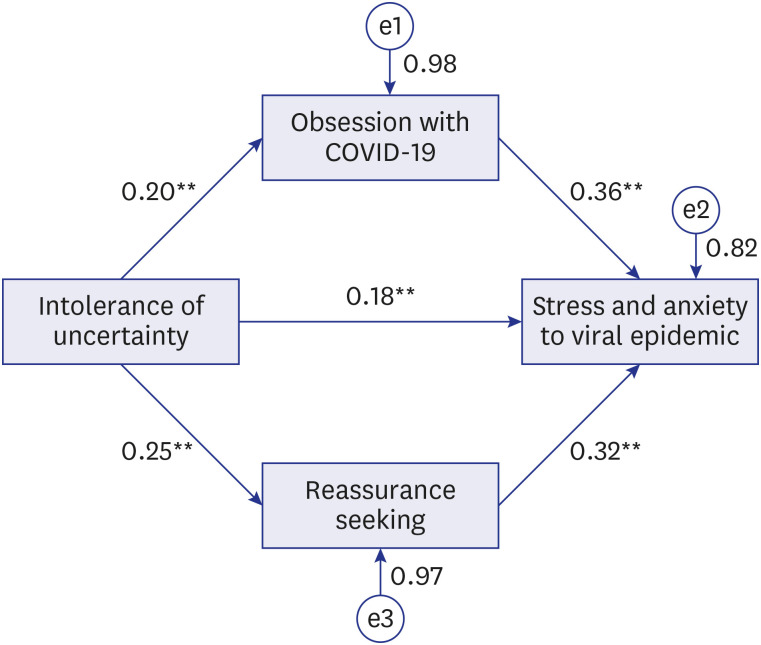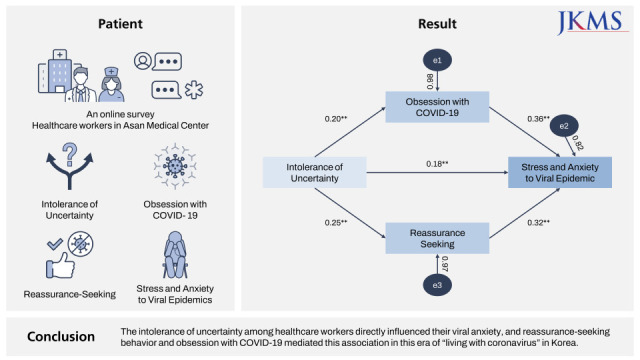1. Chan JF, Yuan S, Kok KH, To KK, Chu H, Yang J, et al. A familial cluster of pneumonia associated with the 2019 novel coronavirus indicating person-to-person transmission: a study of a family cluster. Lancet. 2020; 395(10223):514–523. PMID:
31986261.
3. Luo M, Guo L, Yu M, Jiang W, Wang H. The psychological and mental impact of coronavirus disease 2019 (COVID-19) on medical staff and general public - a systematic review and meta-analysis. Psychiatry Res. 2020; 291:113190. PMID:
32563745.
6. Carleton RN. Into the unknown: a review and synthesis of contemporary models involving uncertainty. J Anxiety Disord. 2016; 39:30–43. PMID:
26945765.
7. Carleton RN. The intolerance of uncertainty construct in the context of anxiety disorders: theoretical and practical perspectives. Expert Rev Neurother. 2012; 12(8):937–947. PMID:
23002938.
8. Buhr K, Dugas MJ. Investigating the construct validity of intolerance of uncertainty and its unique relationship with worry. J Anxiety Disord. 2006; 20(2):222–236. PMID:
16464706.
9. Korkmaz H, Güloğlu B. The role of uncertainty tolerance and meaning in life on depression and anxiety throughout Covid-19 pandemic. Pers Individ Dif. 2021; 179:110952. PMID:
34866725.
10. Carnahan ND, Carter MM, Sbrocco T. Intolerance of uncertainty, looming cognitive style, and avoidant coping as predictors of anxiety and depression during COVID-19: a longitudinal study. Int J Cogn Ther. Forthcoming. 2021; DOI:
10.1007/s41811-021-00123-9.
11. Wu D, Yang T, Hall DL, Jiao G, Huang L, Jiao C. COVID-19 uncertainty and sleep: the roles of perceived stress and intolerance of uncertainty during the early stage of the COVID-19 outbreak. BMC Psychiatry. 2021; 21(1):306. PMID:
34126958.
12. Akbari M, Spada MM, Nikčević AV, Zamani E. The relationship between fear of COVID-19 and health anxiety among families with COVID-19 infected: The mediating role of metacognitions, intolerance of uncertainty and emotion regulation. Clin Psychol Psychother. 2021; 28(6):1354–1366. PMID:
34110670.
13. Doğanülkü HA, Korkmaz O, Griffiths MD, Pakpour AH. Fear of COVID-19 lead to procrastination among Turkish university students: the mediating role of intolerance of uncertainty. BMC Psychol. 2021; 9(1):178. PMID:
34758865.
14. Pak H, Süsen Y, Denizci Nazlıgül M, Griffiths M. The mediating effects of fear of COVID-19 and depression on the association between intolerance of uncertainty and emotional eating during the COVID-19 pandemic in Turkey. Int J Ment Health Addict. Forthcoming. 2021; DOI:
10.1007/s11469-021-00489-z.
15. Chung S, Kim HJ, Ahn MH, Yeo S, Lee J, Kim K, et al. Development of the Stress and Anxiety to Viral Epidemics-9 (SAVE-9) scale for assessing work-related stress and anxiety in healthcare workers in response to viral epidemics. J Korean Med Sci. 2021; 36(47):e319. PMID:
34873885.
16. Barlow DH, Sauer-Zavala S, Carl JR, Bullis JR, Ellard KK. The nature, diagnosis, and treatment of neuroticism: back to the future. Clin Psychol Sci. 2014; 2(3):344–365.
17. Ahn MH, Shin YW, Suh S, Kim JH, Kim HJ, Lee KU, et al. High work-related stress and anxiety response to COVID-19 among healthcare workers: a cross-sectional online survey study in South Korea. JMIR Public Health Surveill. 2021; 7(10):e25489. PMID:
34478401.
18. Gupta S, Sahoo S. Pandemic and mental health of the front-line healthcare workers: a review and implications in the Indian context amidst COVID-19. Gen Psychiatr. 2020; 33(5):e100284. PMID:
34192235.
19. Mhango M, Dzobo M, Chitungo I, Dzinamarira T. COVID-19 risk factors among health workers: a rapid review. Saf Health Work. 2020; 11(3):262–265. PMID:
32995051.
20. Di Trani M, Mariani R, Ferri R, De Berardinis D, Frigo MG. From resilience to burnout in healthcare workers during the COVID-19 emergency: the role of the ability to tolerate uncertainty. Front Psychol. 2021; 12:646435. PMID:
33935905.
21. Aydin A, Ozcan BE. Levels of intolerance of uncertainty, rumination and resilience among healthcare workers during the Covid-19 pandemic. Cukurova Medical Journal. 2021; 46(3):1191–1200.
22. Higgins-Chen AT, Abdallah SB, Dwyer JB, Kaye AP, Angarita GA, Bloch MH. Severe illness anxiety treated by integrating inpatient psychotherapy With medical care and minimizing reassurance. Front Psychiatry. 2019; 10:150. PMID:
30967801.
23. Salkovskis PM, Warwick HM. Morbid preoccupations, health anxiety and reassurance: a cognitive-behavioural approach to hypochondriasis. Behav Res Ther. 1986; 24(5):597–602. PMID:
3753387.
24. Abramowitz JS, Moore EL. An experimental analysis of hypochondriasis. Behav Res Ther. 2007; 45(3):413–424. PMID:
16769034.
25. Carleton RN, Desgagné G, Krakauer R, Hong RY. Increasing intolerance of uncertainty over time: the potential influence of increasing connectivity. Cogn Behav Ther. 2019; 48(2):121–136. PMID:
29882726.
26. Holmes EA, O’Connor RC, Perry VH, Tracey I, Wessely S, Arseneault L, et al. Multidisciplinary research priorities for the COVID-19 pandemic: a call for action for mental health science. Lancet Psychiatry. 2020; 7(6):547–560. PMID:
32304649.
27. Jungmann SM, Witthöft M. Health anxiety, cyberchondria, and coping in the current COVID-19 pandemic: Which factors are related to coronavirus anxiety? J Anxiety Disord. 2020; 73:102239. PMID:
32502806.
28. Jokic-Begic N, Lauri Korajlija A, Mikac U. Cyberchondria in the age of COVID-19. PLoS One. 2020; 15(12):e0243704. PMID:
33332400.
29. Garfin DR, Silver RC, Holman EA. The novel coronavirus (COVID-2019) outbreak: Amplification of public health consequences by media exposure. Health Psychol. 2020; 39(5):355–357. PMID:
32202824.
30. Starcevic V, Schimmenti A, Billieux J, Berle D. Cyberchondria in the time of the COVID-19 pandemic. Hum Behav Emerg Technol. 2020; 11. 23. DOI:
10.1002/hbe2.233.
32. Eysenbach G. Improving the quality of Web surveys: the Checklist for Reporting Results of Internet E-Surveys (CHERRIES). J Med Internet Res. 2004; 6(3):e34. PMID:
15471760.
33. Vivanco-Vidal A, Saroli-Araníbara D, Caycho-Rodríguezb T, Carbajal-Leónb C, Barboza-Palominob M, Reyes-Bossioa M. Evidencia de validez y confiabilidad de la versión en español de la Coronavirus Reassurance-Seeking Behaviors Scale en adultos de Lima, Perú. Ansiedad Estres. 2021; 27(2-3):149–159.
35. Choi E, Lee J, Lee SA. Validation of the Korean version of the obsession with COVID-19 scale and the Coronavirus anxiety scale. Death Stud. 2020; 46(3):608–614. PMID:
34030606.
36. Kroenke K, Spitzer RL, Williams JB. The PHQ-9: validity of a brief depression severity measure. J Gen Intern Med. 2001; 16(9):606–613. PMID:
11556941.
37. Park SJ, Choi HR, Choi JH, Kim K, Hong JP. Reliability and validity of the Korean version of the Patient Health Questionnaire-9 (PHQ-9). Anxiety Mood. 2010; 6(2):119–124.
38. Cho YW, Song ML, Morin CM. Validation of a Korean version of the insomnia severity index. J Clin Neurol. 2014; 10(3):210–215. PMID:
25045373.
39. Seco Ferreira DC, Oliveira WL, Delabrida ZNC, Faro A, Cerqueira-Santos E. Intolerance of uncertainty and mental health in Brazil during the Covid-19 pandemic. Suma Psicológica. 2020; 27(1):62–69.
40. Kim S. The relationship of fear of negative and positive evaluation, intolerance of uncertainty, and social anxiety [master’s thesis]. Seoul: Ehwa University;2010.
41. Taha SA, Matheson K, Anisman H. H1N1 was not all that scary: uncertainty and stressor appraisals predict anxiety related to a coming viral threat. Stress Health. 2014; 30(2):149–157. PMID:
23818424.
42. del Valle MV, Andrés ML, Urquijo S, Yerro-Avincetto M, López Morales H, Canet-Juric L. Intolerance of uncertainty over COVID-19 pandemic and its effect on anxiety and depressive symptoms. Interam J Psychol. 2020; 54(2):e1335.
43. Lee SA. How much "Thinking" about COVID-19 is clinically dysfunctional? Brain Behav Immun. 2020; 87:97–98. PMID:
32353520.
44. Dugas MJ, Ladouceur R. Treatment of GAD. Targeting intolerance of uncertainty in two types of worry. Behav Modif. 2000; 24(5):635–657. PMID:
11036732.
45. Coles ME, Hart AS, Schofield CA. Initial data characterizing the progression from obsessions and compulsions to full-blown obsessive compulsive disorder. Cognit Ther Res. 2012; 36(6):685–693.









 PDF
PDF Citation
Citation Print
Print




 XML Download
XML Download